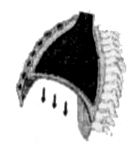Explain the following terms:
angle of reflection.
Draw diagram/diagrams to show them.
Step-by-Step Text Solution:
1. Definition of Angle of Reflection:
The angle of reflection is defined as the angle formed between the normal line (an imaginary line perpendicular to the surface at the point of incidence) and the reflected ray of light.
2. Understanding the Terms:
- Incident Ray: This is the ray of light that strikes the surface (in this case, a mirror).
- Reflected Ray: This is the ray of light that bounces off the surface after striking it.
- Normal Line: This is a line drawn perpendicular to the surface at the point where the incident ray strikes.
3. Diagram Representation:
- Draw a horizontal line to represent the surface of a plane mirror.
- Mark a point on the mirror where the incident ray strikes.
- Draw the incident ray approaching the mirror at an angle (let's call this angle θi).
- At the point of incidence, draw a vertical line perpendicular to the mirror surface. This is the normal line.
- From the point of incidence, draw the reflected ray moving away from the mirror at an angle (let's call this angle θr).
- Label the angles: θi as the angle of incidence and θr as the angle of reflection.
4. Relationship Between Angles:
According to the law of reflection, the angle of incidence (θi) is equal to the angle of reflection (θr). This can be mathematically expressed as:
\(
θi = θr
\)
Diagram:
||Normal||∣| Ref≤ctedRay(θr)|∣∣⊢−−−−−−→IncntRay(θi)
The angle of reflection is defined as the angle formed between the normal line (an imaginary line perpendicular to the surface at the point of incidence) and the reflected ray of light.
- Incident Ray: This is the ray of light that strikes the surface (in this case, a mirror).
- Reflected Ray: This is the ray of light that bounces off the surface after striking it.
- Normal Line: This is a line drawn perpendicular to the surface at the point where the incident ray strikes.
- Draw a horizontal line to represent the surface of a plane mirror.
- Mark a point on the mirror where the incident ray strikes.
- Draw the incident ray approaching the mirror at an angle (let's call this angle θi).
- At the point of incidence, draw a vertical line perpendicular to the mirror surface. This is the normal line.
- From the point of incidence, draw the reflected ray moving away from the mirror at an angle (let's call this angle θr).
- Label the angles: θi as the angle of incidence and θr as the angle of reflection.
According to the law of reflection, the angle of incidence (θi) is equal to the angle of reflection (θr). This can be mathematically expressed as:
\(
θi = θr
\)
||Normal||∣| Ref≤ctedRay(θr)|∣∣⊢−−−−−−→IncntRay(θi)
Topper's Solved these Questions
- REFLECTION OF LIGHTBOOK - ICSECHAPTER - REFLECTION OF LIGHTEXERCISE - EXERCISE 7(B)
9 Videos
- REFLECTION OF LIGHTBOOK - ICSECHAPTER - REFLECTION OF LIGHTEXERCISE - EXERCISE 7(C)
54 Videos
- REFLECTION OF LIGHTBOOK - ICSECHAPTER - REFLECTION OF LIGHTEXERCISE - EXERCISE 7(C)
54 Videos
- PROPAGATION OF SOUND WAVES BOOK - ICSECHAPTER - PROPAGATION OF SOUND WAVES EXERCISE - EXERCISE -8(B) (Multiple choice type)
3 Videos
- SOUNDBOOK - ICSECHAPTER - SOUNDEXERCISE - TOPIC 2 Infrasonic and Ultrasonic Waves ( 3 Marks Questions)
3 Videos
Similar Questions
Explain the following terms:
angle of incidence and
Draw diagram/diagrams to show them.
View SolutionExplain the following terms:
reflected ray
Draw diagram/diagrams to show them.
View SolutionExplain the following terms:
plane mirror
Draw diagram/diagrams to show them.
View SolutionExplain the following terms:
incident ray
Draw diagram/diagrams to show them.
View SolutionExplain the following terms :
Reflected ray
View SolutionIn the following diagram, what kind of reflection is given?

View SolutionThe following diagram explains

View SolutionExplain the term critical angle with the aid of a labelled diagram.
View SolutionDraw diagrams to show the formation of beats?
View SolutionDraw a labelled diagram of synapse.
View Solution
